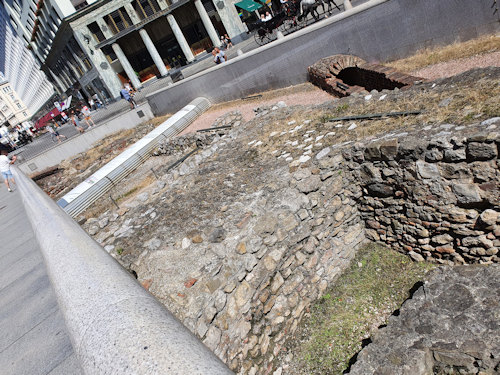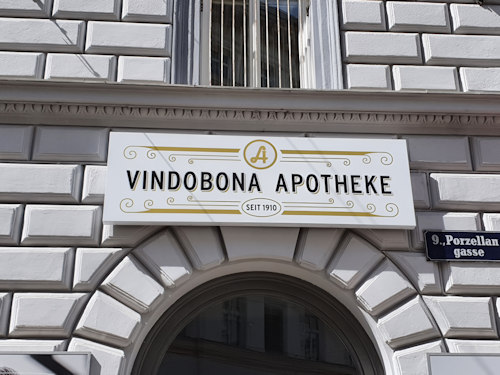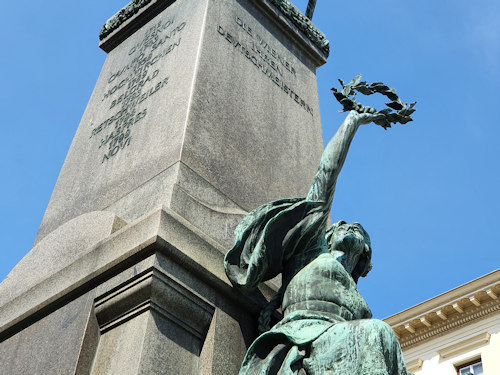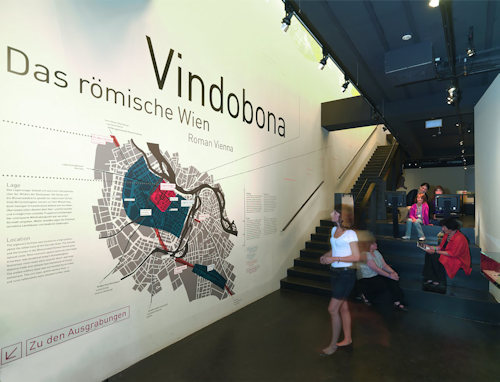
Cast your mind back a few years. Around 2000 in fact. Long before Vienna echoed to the sound of violins and pianos, you could hear the stamp of Roman legions marching through the streets.
Here a quick overview of Vienna’s Roman history and what remains of it to experience today.
- At its peak, “Vindobona” housed around 30,000 people
- Military camp, military settlement and civilian town
- Much of the city centre stands on the former Roman site
- Roman history still influences, for example, street names
- Only a few physical remains are visible
- See also:
Vindobona

(Roman excavations on Michaelerplatz)
Vienna’s history tends to focus on its position as the administrative centre of the Habsburg lands and the residence of various emperors and empresses.
But the city has imperial connections that go back to an era when all those Leopolds and Maximiliens were still centuries away from building the first Habsburg castles among the forested slopes of Switzerland.
At a time when the greatest threat to local sensibilities was not a poorly-played waltz but an incursion by barbarian hordes, Vienna was Vindobona: a Roman military camp and associated settlement.
The location reflected its strategic value; the Danube marked the border between the Roman Empire and the German tribes, so Vindobona formed one of a series of defensive military positions along the river.
(UNESCO has Austrian and Viennese parts of this Roman frontier on its World Heritage List.)
Further east, you had the even larger Carnuntum, now a lovely archaeological park. Vindobona also protected important trade routes.
At its peak, the military fort here with associated military and civil settlements had a population of around 30,000; the Roman presence lasted roughly 350 years from the early 1st century.
What remains of Roman Vienna?

(Roman soldiers once slept on the site of the Park Hotel Hyatt. Apparently the breakfast buffet was significantly different)
The camp and surrounding settlement(s) roughly match up with much of the current first district, i.e. “old Vienna” and the very centre of today’s city, though the civil Roman town extended out into today’s 3rd district.
The Graben street that forms the pedestrianised heart of the city may have marked one side of the fortifications, for example. (Graben actually means ditch or trench.) The layout of the city centre probably reflects in part the structure of the original Roman camp.
The Park Hotel Hyatt on Am Hof square apparently stands on top of former Roman barracks. And we also know the Hoher Markt area once housed Roman officers.
Inevitably, centuries of construction works and urban development erased almost all trace of Vindobona above ground. But you can still find actual Roman remains and echoes of the era in modern Vienna.

(Stone from a Roman Baths in Vindobona)
Building works often reveal evidence of Roman times. For example:
- Michaelerplatz square at one entrance to the Hofburg palace complex spent part of its life as a crossroads where east-west and north-south trade routes met. The redesign of the square in the early 1990s included extensive excavations that exposed, for example, the remnants of Roman dwellings.
Part of those excavations remain open to public view in a special display across the square’s centre.
- Walk east down Sterngasse and you’ll reach a stone cuboid that formed part of some Roman baths; it turned up in 1962 during the demolition of a building.
The word Vindobona also survives in business, product, ship, street, and train names. For example, this pharmacy on Porzellangasse:

(The Vindobona Apotheke)
Today’s Marc-Aurel-Straße (which starts at one end of Hoher Markt) pays tribute to the historical fact that Emperor Marcus Aurelius (121-180) of Gladiator fame stayed in Vindobona. Some claim he even died in the city.
The Roman term also finds use as the female personification of Vienna.
For example, the huge Albrechtsbrunnen fountain below the Albertina museum has the figures of Danubius and Vindobona serving as allegories for the Danube river and the city:

(Danubius’s arm around Vindobona perhaps reflects the course of the Danube embracing Vienna)
The regimental monument on Deutschmeisterplatz has Vindobona holding up a laurel wreath toward the flag-carrying soldier that tops the plinth:

(The Deutschmeisterplatz military monument)
The main carved stone figure on the central tower of the 19th-century Rathaus also represents Vindobona.
Where to learn more
Three top places for you…
The Roman Museum
The Wien Museum has a location on Hoher Markt dedicated to Vienna’s Roman past. The Römermuseum incorporates on-site excavations, though the bulk of the displays explore the history of Vindobona and the lives of the inhabitants.

(Inside the Roman Museum in Vienna; photo by Birgit und Peter Kainz © Wien Museum)
Wien Museum Karlsplatz
The main Wien Museum location on Karlsplatz covers all of Vienna’s history, but the initial chapters of your journey into the past include a room or two dedicated to the city’s Roman heritage and the interactions between the locals and their new rulers.
The Kunsthistorisches Museum
Not specifically related to Vindobona per se, but the prestigious Kunsthistorisches Museum has an entire section dedicated to Greek and Roman antiquities. Look, particularly, for the cameos and engraved gems.